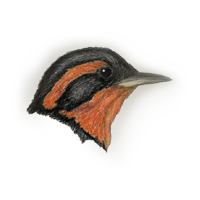|
Field
Guide IDs: BREEDING:
Moist coniferous
forest and deciduous forest with dense understory.
2? broods. DISPLAYS:
Agonistic: head
extended forward with body held in horizontal
crouch, plumage sleeked; at highest intensity, tall
lifted and spread, wings spread and rotated
forward. NEST:
Usu against trunk
in small conifer; bulky, of mud, dried leaves,
inner bark strips, soft moss, reinforced with
twigs, lining of grass or rootlets. EGGS:
Pale blue, flecked
with brown. 1.2" (30 mm). DIET:
Includes sowbugs,
myriapods, snails, worms; much fruit, weed seeds,
and acorns in winter. Young probably fed
exclusively animal diet. CONSERVATION:
Winters s to n
Baja. NOTES:
Song is an eerie,
bell-like, prolonged whistle that slowly fades away
from the listener. Breeding biology not well known.
Aggressive toward other species at winter feeding
sites. Fairly rare to
uncommon resident from fall through spring. Occurs
in a number of areas on campus, usually in more
heavily vegetated areas than those used by the
similar American Robin, although it is often found
in flocks of robins. A few can be found near the
Mausoleum in winter. ESSAYS: Feeding
Birds;
Bathing
and Dusting;
How
Do We Find Out About Bird
Biology? REFERENCES:
Martin,
1970. |
